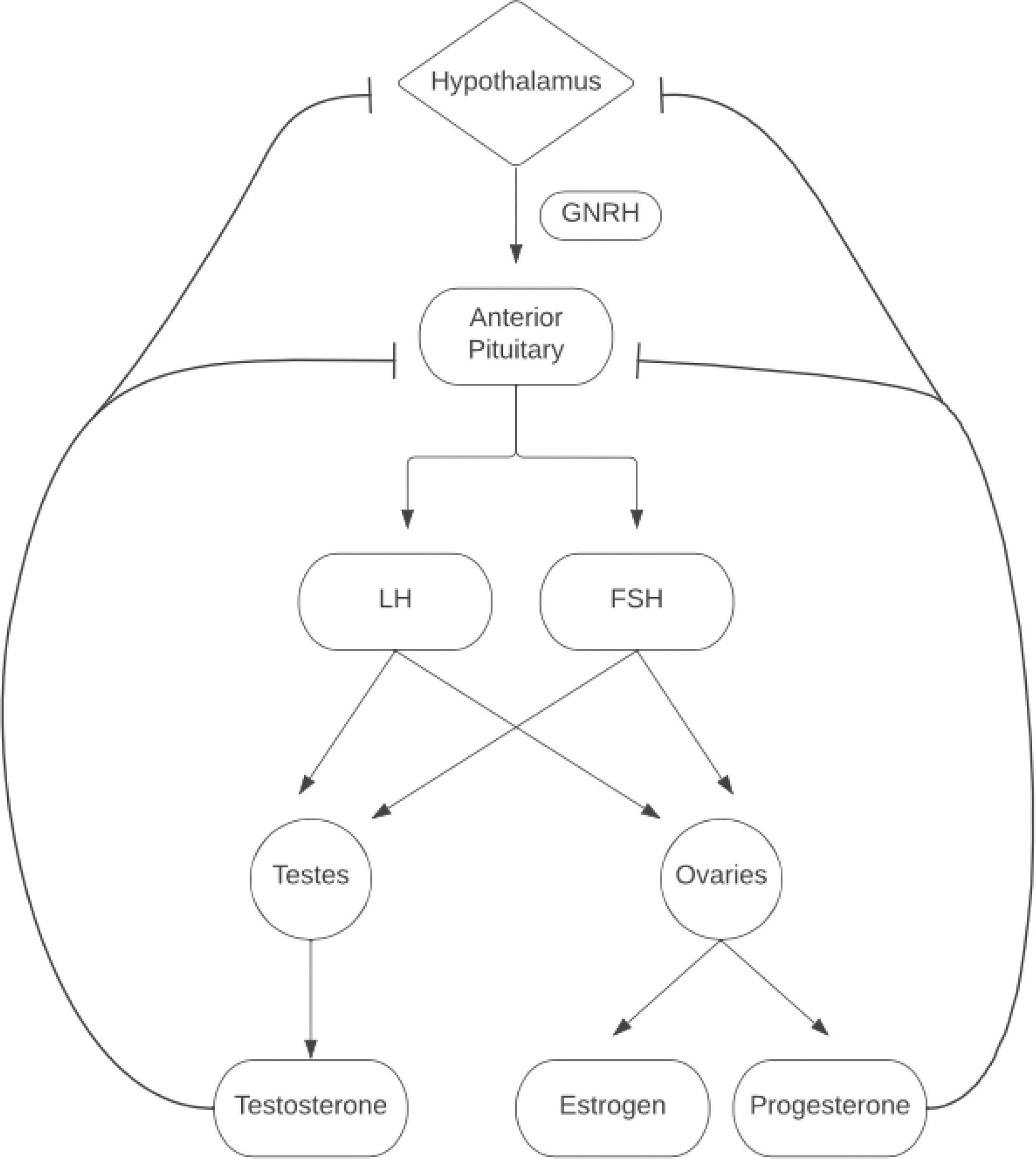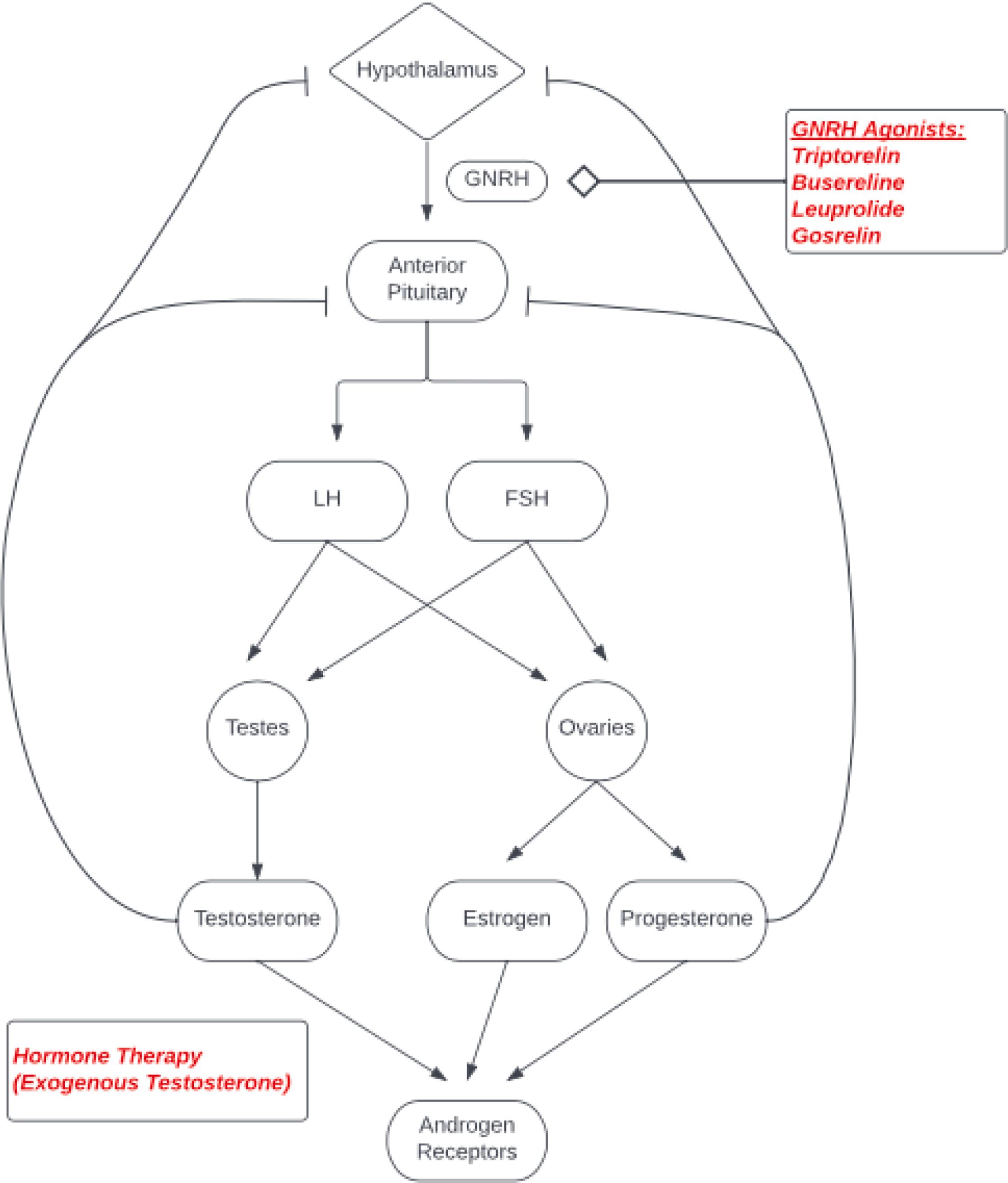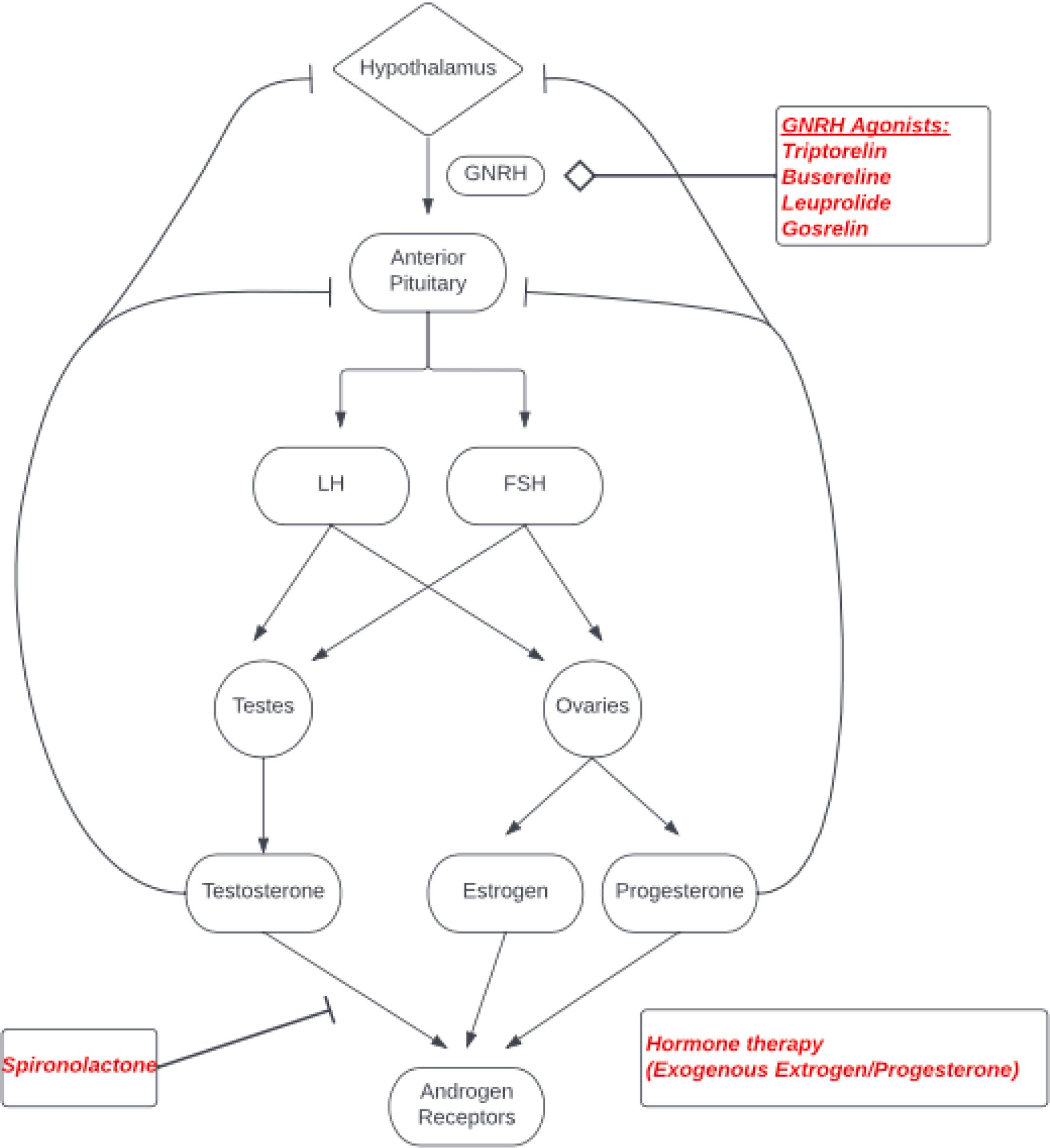Physical Address
304 North Cardinal St.
Dorchester Center, MA 02124
The estimated prevalence of transgender individuals in the United States is 390 in 100,000 [ ]. In order to better care for the transgender athlete, a provider must understand the biochemical changes that occur during gender transition and their potential effect on athletes' physiology, injury risk, and performance. It is important to gather a detailed history on pharmacological agents and other interventions used throughout patients' transition, as treatments can be highly individualized. Determinants such as age at the time of gender transition and history of pubertal suppression are also relevant, as they bear upon musculoskeletal physiology. Close examination of agents involved in treatment and their effects lends insight into potential implications for the musculoskeletal health and development of the individual athlete. In this chapter we examine the use of medication in isolation, however the interplay of medications, along with fluctuations in hormone levels play a significant role in the musculoskeletal pathology.
The hypothalamic–pituitary–gonadal (HPG) axis governs the production of endogenous sex hormones and plays a central role in sex development and the formation of secondary sex characteristics ( Fig. 4.1 ). Pulsatile secretion of Gonadotropin Releasing Hormone (GnRH) from the hypothalamus stimulates the anterior pituitary to secrete Luteinizing Hormone (LH) and Follicle Stimulating Hormone (FSH), which in turn act upon male and female reproductive end organs. Hormonal action at the gonads results in the production of reproductive cells and sex hormones—primarily, testosterone from the testes and estrogen and progesterone from the ovaries.

Gender-affirming hormone therapy (GAHT) regimens target one or more actions of the HPG axis to align sexual development and secondary sex characteristics with one's gender identity. GnRH agonists (GnRHa) such as leuprolide, which have traditionally been used for conditions including precocious puberty and endometriosis, are often used as pubertal blockers in transgender patients. Use of GNRHa in transgender patients induces a hypogonadal state, resulting in a development arrest of undesired secondary sex characteristics, such as breast growth, hand and foot size, height, voice deepening, facial structure changes, and facial hair [ , ]. GNRHa may be provided until a patient undergoes gonadectomy, should the patient elects to undergo this procedure.
In addition to suppressing puberty, hormone replacement therapy may be provided to induce gender transition. Trans males (female to male) are often provided with testosterone supplementation. Testosterone has many effects on the body including facial hair growth, muscle mass increase, and body fat redistribution. In trans males, testosterone is provided intramuscularly or transdermally with a desired goal of 13–24 nmol/L [ ] ( Fig. 4.2 ).

Conversely, trans females (male to female) are given estrogen, along with androgen blockers such as spironolactone or cyproterone acetate to reduce testosterone's effects on the body ( Fig. 4.3 ). The goal testosterone level in the trans female population is usually <1.7 nmol/L [ ]. In some instances, threshold for trans female competition has often been determined to be <10 nmol/L, although this may vary by sport and method of testing. Of note, the upper limit of testosterone levels in nonvirilized natal females is near 3 nmol/L. Estrogen supplementation which leads to characteristics such as body fat redistribution, breast development, and decrease in lean body mass, is often provided to trans females, either transdermally or orally. Goal estradiol levels are around 100–200 pg/mL [ ].

These agents have complex effects on musculoskeletal physiology, apart from their therapeutic roles in gender-affirming treatment. As such, providers must be aware of potential unintended musculoskeletal effects associated with GAHT. The following sections review the existing literature surrounding these topics and how this information may be applied in the context of the transgender athlete. They provide an analysis of several major therapeutic agents and comment on their known effects on musculoskeletal health, physiology, and injury.
Bone health is important in all athletes and is essential in athletic performance. There are multiple influences on bone health including both modifiable and nonmodifiable risk factors. Hormone health and optimization plays a crucial role in supporting bone health. In the transgender population, hormone therapy may cause alterations in bone health and it is imperative that a provider treating this population understand potential effects.
It is important to consider the effects of using GnRHa such as leuprolide, not only in the general transgender population but also in the transgender athlete. During puberty, the rise of sex hormones contributes to bone mass development and by the age of 18 years old approximately 90% of peak bone mass is achieved [ ]. The use of GNRHa delays bone mineralization and the closing of epiphyses. It has been observed that the use of pubertal suppression in transgender adolescents has been shown to decrease in growth velocity and height, compared to natal sex counterparts [ , ]. It is unclear if arresting the pubertal process with a GNRHa may have long term side effects in the transgender population, including the possible increase in the incidence of fractures and osteoporosis. The long-term effects are not yet known.
Multiple studies have shown that trans females often begin the transition process with lower baseline BMD than trans males [ , ]. This is believed to be due to relative lower levels of physical activity in the trans female population. In a study by Schagen et al., 51 trans girls and 70 trans boys were found to have significantly decreased bone markers while on GNRHa. After the start of gender affirming hormone treatment, z -scores in trans boys normalized, whereas z -scores of trans girls remained below the population mean [ ]. A study by Klink et al. demonstrated similar decrease in z -score in trans girls from 0.8 to −1.4, whereas in trans males, there was a decrease between 0.2 and −0.3 further suggesting that use of GNRHa may lead to permanent lower BMD in this population, particularly trans females [ ]. In a study by Vlot et al., 34 trans males and 22 trans females demonstrated decreased z -scores over 2 years of GNRHa, although the overall fracture risk after 12 months was not determined [ ]. It should also be considered that most of these effects on bone mineral density have been observed before the use of cross-sex hormone therapy and some studies suggest the effects of cross-sex hormone therapy appears to restore BMD to natal sex counterpart levels while another study suggests partial normalization of levels [ , ]. It is recommended that transgender patient on GNRHa have DEXA scans at the start of GNRHa and every 2 years during treatment to monitor changes in BMD [ ].
In addition to pubertal suppression, trans females may also be given antiandrogen medication such as spironolactone to further suppress the effects of testosterone on the body. Spironolactone has been used in the treatment of hyperaldosteronism and has been shown to reduce bone turnover markers in postmenopausal women with this condition [ ]. One may further infer mineralocorticoid receptor antagonist effects of spironolactone may enable resorption of calcium and thus reduce PTH levels, similar to the effects seen in other diuretics on bone health [ , ]. At this time, there are no studies that examine the clinical impact of spironolactone therapy on long-term bone health in the male to female transgender population.
Both estrogen and testosterone are crucial for the regulation of bone metabolism in both men and women. Estrogen acts on osteocytes, osteoblasts, and osteoclasts to decrease activation of bone remodeling and help preserve the maintenance of bone formation [ , ]. There is a positive correlation between estrogen levels and bone mineral density which has been studied extensively in postmenopausal women [ ]. For this reason, postmenopausal women are at high risk for developing osteoporosis as estrogen levels rapidly decline [ ]. It is important to monitor bone density as estrogen levels decline in trans men. After ovariectomy in trans men, which mimics menopause, BMD has been shown to be stable over 12 months, but decreases over the 28–63 months [ ]. In this same study, trans females studied demonstrated that estrogen therapy preserved BMD after testosterone deprivation with significant increase after 1 year, although BMD ultimately decreased to baseline after 28–63 months of treatment [ ].
Testosterone is also important in the maintenance of BMD. Testosterone acts on the IGF-1 and TGB-beta receptors in osteoblasts to promote bone formation. In addition to testosterone's effects on the these receptors, testosterone is converted to estrogen via aromatase which further encourages bone formation. It has been observed in aging natal males and males on androgen reduction therapy, that BMD decreases as testosterone levels decrease. It is important to consider the changing both estrogen and testosterone levels in transgender athletes when assessing bone health [ ].
Clinical considerations of this data would suggest optimizing other forms of bone mineral formation such as screening for vitamin D deficiency, calcium and vitamin D supplementation, encouraging weight-bearing exercise, as well as limiting other risk factors for BMD loss such as smoking and alcohol use. In addition, the period between starting GnRHa and cross-sex hormone therapy lends itself to be a vulnerable time in terms of bone mineral density when epiphyseal fusion is arrested, but maintenance hormonal therapy has not yet started [ , ]. Threshold for stress fracture evaluation may be somewhat lower in a transgender person who has been on pubertal suppression therapy as they may have not reached peak BMD when this therapy is suspended.
Current guidelines for bone density screening in adult transgender people is similar to the same the general population, which includes screening at age 65, and younger if risk factors are present. Transgender people who have undergone gonadectomy without HRT for at least 5 years should be considered for screening [ ].
Additionally, excessive exercise and malnourishment can lead to the down regulation of the hypothalamus-pituitary axis leading to a functional hypothalamic amenorrhea in young active female or transgender athletes, significantly increasing their risk of stress fractures. Therefore, providers shoulder have a low threshold for fracture screening, particularly with endurance or weight class-dependent athletes or in the setting of even minimal trauma. Standardized z -scores used to assess BMD are age and gender matched values. It is unclear the relevance of these scores as the hormonal milieu of the patient changes. Providers should also be aware of hormonal medication access and compliance, as rapid changes or cessation of medication can have detrimental effects on bone health. It is important to remember that treating low BMD goes beyond simply providing oral or transdermal hormone therapy, and requires full assessment of training volume, nutritional intake, vitamin D and electrolyte levels, thyroid function tests, and psychological factors.
Become a Clinical Tree membership for Full access and enjoy Unlimited articles
If you are a member. Log in here